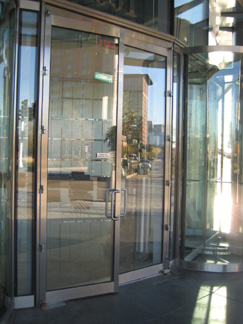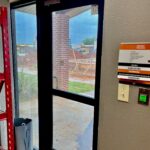 I was walking down the street the other day, and I noticed that all of the entrance doors on the building I was passing had A LOT of intermediate pivots. I didn’t have much time to investigate, but I took a picture in case I decided to do a blog post about it someday. Well, someday is today because I just got an email from one of our specwriters about how to determine the required quantity of intermediate pivots.
I was walking down the street the other day, and I noticed that all of the entrance doors on the building I was passing had A LOT of intermediate pivots. I didn’t have much time to investigate, but I took a picture in case I decided to do a blog post about it someday. Well, someday is today because I just got an email from one of our specwriters about how to determine the required quantity of intermediate pivots.
Intermediate pivots are typically used with a set of top and bottom pivots, or a top pivot and a floor closer. The bottom pivot carries much of the door weight, and the primary purpose of the intermediate pivots is door/frame alignment (although most manufacturers’ data states that greater door weight can be accommodated when intermediate pivots are used).
The rule of thumb is that doors over 60″ tall require one intermediate pivot, and an additional intermediate pivot for each additional 30″ of height. So if I’m interpreting that correctly, a door up to 89″ tall would have 1 intermediate pivot (in addition to the top and bottom pivot set), a door up to 119″ tall would have 2 intermediate pivots, and a door up to 149″ tall would have 3 intermediate pivots.
The formula for pivots is different from the way you determine hinge quantity. With hinges, you use 2 for the first 60″ of door height and then an additional hinge for each 30″ of door height. So a 7′ door would have 3 hinges, or one intermediate pivot + the top and bottom pivot set.
Unless the doors at right are REALLY tall, I think they have more than enough intermediate pivots.
You need to login or register to bookmark/favorite this content.






heeheh great post to start my day with, although my “overkill detector” went off reading this,yea, that’s just one too many pivots there for a 7 or 8 ft door now lets just hope that the owner of this building has stock in ASSA ABLOY or ingersoll rand (in the case these pivots are made by either RIXSON (company owned by ASSA ABLOY, floor closer/pivot maker) or dor-o-matic (ingersoll-rand’s floor closer)
I hope this is not a result of me telling some that have asked me closer questions about if the closer should take any weight of the door, if any that have that question and read this post,
surface closers=NO WEIGHT FROM DOOR SHALL BE PUT ON THEIR ARM, just the force that is required to pull the door shut.
weight of door on a surface closer’s arm can cause premature o-ring wear at the closer’s spindle/pivots(were arm attaches to closer body)
floorsprings/floorclosers=yes, you can have some of the door’s weight on the spindle of the closer. not sure how much weight they can take but there are Rixson floorclosers out there are rated to about 1000 pounds of door weight.
……….more knowledge spilled by a door closer expert,
Lori, hope your feeling better
-Jess
Hmmmm….ignorance or upsell?? What do you think the case was?? Just curious.
I think it was just a mistake. When someone “loads up” a project, its not usually in the hinge/pivot quantity.
Do you have any data on how much additional resistance is added (if any) to the required door opening force by unnecessarily adding additional hinges (or intermediate pivots), or, does the unnecessary additional hinge or pivot help reduce door opening force at all (assuming all hinges are in proper alignment and no hinge bind is occurring). These days we are looking at all possible means of reducing door opening for especially at non-rated openings.
hmm. interesting. Thanks for sharing!